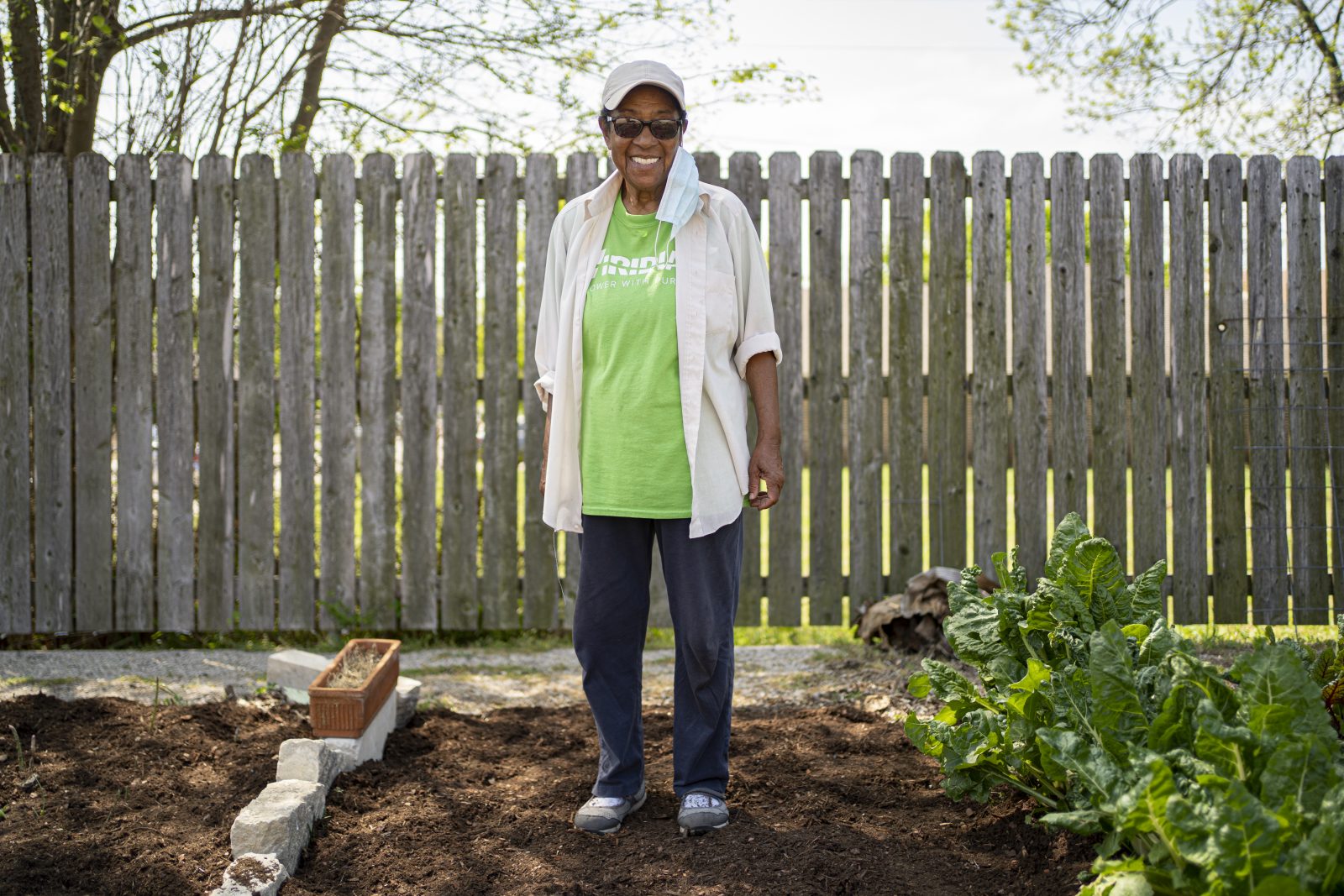In Dallas’ food deserts, community gardens ease — but don’t end — hunger pangs

Neyssa Shockley recently planted the first peach tree on her family’s empty lot in the historic Wheatley Place neighborhood just south of Fair Park. Peaches were her father’s favorite.
“You won’t meet a person around here who doesn’t recognize my father’s name,” says Shockley, 31. Her father was James “Skip” Shockley, an activist and member of the Dallas Black Panther Party. “Community meant everything to him.”
Her father died last May from sickle cell anemia at the age of 72. His final request to his wife, Mayra, and his daughter was to turn the family land into a community garden. The land sat empty after a fire destroyed their home in 2013.
The lot has been in Shockley’s family since 1950. Her great aunt once grew mint, carrots, onions, potatoes and tomatoes. “For as long as I can remember, we’ve grown food on this land,” Neyssa Shockley says.
Community gardens like Shockley’s have been a way of life for people in South Dallas for years. Without a nearby grocery store, residents have often had to rely on their own gardening skills for fresh fruits and vegetables.
But while such gardens are important for a small number of families, experts say they do little to combat food insecurity outside of their own neighborhoods. To be more effective, cities need to support these community gardens, as demonstrated by an innovative program in Austin, experts say.
The American Community Garden Association says there are less than a dozen community gardens in South Dallas.
“These gardens operate in silos without any kind of support from the city other than perhaps a grant that helps with their start-up costs,” said Candace Thompson, a Dallas community gardener and doctorate student who is studying the intertwining of land, food and faith. “Without additional support, these gardens can help their neighbors but don’t have a chance at reaching the amount of people they need to in order to change South Dallas’ food desert status.”
South Dallas is in an area designated a food desert by the U.S. Department of Agriculture. That means 20% of the population lives at or below the poverty level and more than a third live at least one mile away from the nearest grocery store.
According to Feeding America, 391,671 people in Dallas struggle with food insecurity and 21% of all children do.
Meanwhile, a community survey showed that as many as 45% of the people in the South Dallas’ ZIP codes of 75210 and 75215 don’t have cars. “A lot of people here are struggling to afford groceries as it is,” Shockley says. “You add a transportation issue and limited access to food to the mix and the situation just becomes dire.”
‘This is food apartheid’
“This is not a food insecurity issue, and this is not a food desert. This is food apartheid,” says Ples Montgomery IV, president of The Oak Cliff Veggie Project, a nonprofit focused on making the community “stronger, healthier and more self-reliant” through nutrition and gardening.

Terms like “food desert” and “food insecurity” Montgomery says, don’t accurately convey the role that racism has played in creating South Dallas’ struggle with hunger.
“Food apartheid means [that] the suffering this community is enduring now was, at least at one point, caused intentionally,” Montgomery says. “The community’s ancestors were forced to find ways to make their own food because 80-some years ago, segregation and redlining made accessing food even harder for them than it is for their descendants today.”
To truly combat food insecurity, these community gardens can’t continue to operate in silos with minimal funds, Montgomery says.
“What these community gardeners are doing is wonderful,” he says. “But we need much more of it — more aggregation and more local production.”
He says there needs to be a large-scale, collaborative approach spearheaded by the city of Dallas.
An Austin resolution
Montgomery and others point to another Texas city for a potentially effective approach involving community gardens.
In Austin, St. David’s Foundation Community Garden and others like it benefit from the Sustainable Urban Agriculture and Community Garden Resolution, which was passed by Austin’s city council in 2009.
The measure allows community gardens to operate on public property, so Austin residents don’t have to own their own land to create a garden. More gardens mean more produce for hungry Austin citizens and a healthier city overall, Montgomery says.

Becca Montjoy is the communications director for Austin’s Sustainable Food Center, a nonprofit organization dedicated to creating equitable food distribution in Austin and central Texas. Montjoy helped create St. David’s Foundation Community Garden, which sits adjacent to the nonprofit’s headquarters.
“When we were first building the garden, I was getting my hands dirty like everyone else,” Montjoy says.
The community garden launched in 2013 as a way to strengthen community ties, enhance the health of Austin residents and address food insecurity in South East Austin, Montjoy said.
Corey Pudhorodsky, who is on the leadership council for the St. David’s, says the garden is funded through membership fees, donations from the public, and taxpayer dollars, thanks to the Austin resolution.
Local community gardeners pay $50 a year for membership, which allows them to farm on one of the garden’s 55 reserved 10-by-20 foot plots. Several plots are “communal,” Pudhorodsky says, and allow for anyone to reap the harvest. Likewise, five plots can be rented for free for those who can’t afford the annual membership fee. Most gardeners donate a portion of their harvest to local food banks.
“The city’s resolution certainly upped our efforts,” Pudhorodsky says. “If we need help cleaning the garden up after a storm or just maintaining the garden to a certain extent, the city steps in to help.”
The 2009 city resolution also created the City of Austin Community Garden Program, connecting the dots between all the efforts that make up Austin’s local food system. The program is led by a five-member council that helps aspiring gardeners navigate the application process and build partnerships around local food production.
Montjoy says the city resolution paved the way for one of Austin’s most popular initiatives, the Fresh for Less Mobile Market program. Austin residents can use food stamps to buy fresh fruits and vegetables that are delivered to their homes.
“This helps us feed some of Austin’s most vulnerable individuals, including children,” Montjoy says.
The Fresh for Less Mobile Market community garden grows on public property, Montjoy says. The program can deliver food to customers for a fraction of the cost because the city pays for the garden’s maintenance. The 2009 resolution creating a collaboration between city leaders and community gardeners has made all of the difference in tackling food insecurity in Austin, Montjoy says.
Austin’s Community Gardens are producing about 100,000 pounds of fresh local, organic produce for Austin residents every year, according to the city. Initially, however, the program received some pushback from some city leaders and Austin residents.
“There were people who argued that gardeners already had everything they needed,” Montjoy says. “And that supplying taxpayer dollars to community gardens would be a waste.”
The cost for the city of Austin has been the addition of one full-time dedicated staff position who oversees the entire program. For the last couple of years, a $10,000 budget has been added to help with administrative costs. Additional financial support of the Austin Community Gardens Program comes from partnerships, grants, smaller-scale donations and membership fees generated by the individual community gardens.
Montjoy says since the resolution passed, community gardens have doubled in Austin. “This could be Dallas,” Montjoy says. “This really could be anywhere.”
In Dolphin Heights

Anna Hill can see the benefit of a program like Austin’s. She and her late husband started the Dolphin Heights Community Garden more than 15 years ago — just a couple of miles from Shockley’s garden. She says having a collaboration between the city, the community and community gardeners would help get fresh produce to more neighborhood residents.
“We’ve always wanted to help the people,” Hill says. “But there was only so much we could do.”
Last year was difficult for Hill. Her husband, Willie Hart, died in May from complications from his cancer treatment.
“This was his true love,” Hill says as she gazes over the garden. “He was out here working on this garden all day, every day, from sun up to sun down. I’d have to remind him to come inside to eat.”
The garden sits on an empty lot next to Hill’s house and produces fresh fruits, vegetables and eggs from a chicken coop. Hill donates her harvest to the North Texas Food Bank and to Dolphin Heights neighborhood’s Progressive Baptist Church food pantry.
“They’ve always had people come but since COVID hit, the lines have just gotten longer and longer; people line up around the block now,” Hill says.
With greater community needs, Hill says taking care of the garden without her husband is difficult. She recently received a grant to hire a gardener.
“This is a full-time job,” she says. “If you really want your garden to be a success, where it’s helping feed people, you cannot just work it like a hobby.”
This story is part of a project on potential solutions to food insecurity in the neighborhoods of South Dallas and West Dallas. It’s reported through a partnership of the nonprofit Dallas Free Press and The Dallas Morning News, with support from the Solutions Journalism Network. For more information, email info@dallasfreepress.com.








Good Story